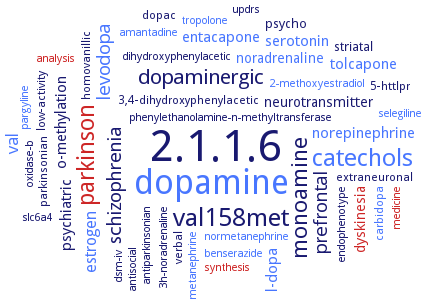2.1.1.6: catechol O-methyltransferase
This is an abbreviated version!
For detailed information about catechol O-methyltransferase, go to the full flat file.

Word Map on EC 2.1.1.6 
-
2.1.1.6
-
dopamine
-
val158met
-
catechols
-
parkinson
-
monoamine
-
dopaminergic
-
schizophrenia
-
prefrontal
-
levodopa
-
estrogen
-
val
-
o-methylation
-
psychiatric
-
norepinephrine
-
entacapone
-
l-dopa
-
tolcapone
-
serotonin
-
noradrenaline
-
dyskinesia
-
neurotransmitter
-
striatal
-
psycho
-
dopac
-
carbidopa
-
verbal
-
3,4-dihydroxyphenylacetic
-
extraneuronal
-
5-httlpr
-
low-activity
-
parkinsonian
-
homovanillic
-
normetanephrine
-
benserazide
-
antiparkinsonian
-
synthesis
-
endophenotype
-
dsm-iv
-
3h-noradrenaline
-
2-methoxyestradiol
-
analysis
-
tropolone
-
updrs
-
slc6a4
-
dihydroxyphenylacetic
-
amantadine
-
pargyline
-
oxidase-b
-
phenylethanolamine-n-methyltransferase
-
metanephrine
-
selegiline
-
medicine
-
antisocial
- 2.1.1.6
- dopamine
-
val158met
- catechols
- parkinson
-
monoamine
-
dopaminergic
-
schizophrenia
-
prefrontal
- levodopa
- estrogen
- val
-
o-methylation
-
psychiatric
- norepinephrine
- entacapone
- l-dopa
- tolcapone
- serotonin
- noradrenaline
- dyskinesia
-
neurotransmitter
- striatal
-
psycho
-
dopac
- carbidopa
-
verbal
-
3,4-dihydroxyphenylacetic
-
extraneuronal
-
5-httlpr
-
low-activity
-
parkinsonian
-
homovanillic
- normetanephrine
- benserazide
-
antiparkinsonian
- synthesis
-
endophenotype
-
dsm-iv
-
3h-noradrenaline
- 2-methoxyestradiol
- analysis
- tropolone
-
updrs
-
slc6a4
-
dihydroxyphenylacetic
- amantadine
- pargyline
-
oxidase-b
-
phenylethanolamine-n-methyltransferase
- metanephrine
- selegiline
- medicine
-
antisocial
Reaction
Synonyms
catechol methyltransferase, catechol-O-methyl transferase, catechol-O-methyl transferase, membrane bound, catechol-O-methyl transferase, soluble, catechol-O-methyltransferase, catechol-O-transferase, catecholamine O-methyltransferase, COMT, COMT I, COMT II, COMT-mb, COMT-s, COMT1, COMT2, CTOMT1, L-COMT, MB-COMT, methyltransferase, catechol, S-COMT, SCOMT
ECTree
Advanced search results
Crystallization
Crystallization on EC 2.1.1.6 - catechol O-methyltransferase
Please wait a moment until all data is loaded. This message will disappear when all data is loaded.
bidentate and monodentate binding modes of substrate catecholamine are close in energy but separated by a 7 kcal/mol free energy barrier. The driving force for monodentate catecholate orientations in classical molecular dynamics simulations is derived from stronger electrostatic stabilization afforded by alternate Mg2+ coordination with strongly charged active site carboxylates. Mixed semi-empirical-classical substrate C-O distances (2.7 A) for the bidentate case are in agreement with COMT X-ray crystal structures, as long as charge transfer between the substrates, Mg2+, and surrounding ligands is permitted. Free energy barriers for methyl transfer from bidentate and monodentate catecholate configurations are comparable at around 21-22 kcal/mol
quantum mechanical/molecular mechanical dynamics analysis of the effect of metal substitution on the rate determining step in the catalytic cycle of COMT, the methyl transfer. In full accord with experimental data, Mg(II) bound to COMT is the most potent of the studied cations and it is closely followed by Fe(II), whereas Fe(III) is unable to promote catalysis. Ca(II) induces a repacking of the protein binding site, leading to a significant increase in the activation barrier and higher energy of reaction. The effect of metal substitution is different for different metals: for Fe(III) it is the electronic effect, for Ca(II) it is the effect of suboptimal protein structure
sitting-drop vapor-diffusion method, crystal structures of the 108V and 108M variants of the soluble form of human COMT bound with S-adenosylmethionine and a substrate analog, 3,5-dinitrocatechol
soluble enzyme form, in complex with inhibitor shows chelation of the active site magnesium
struktures of soluble isoforms in complex with inhibitors, S-adenosyl-L-methionine and Mg2+
apo and holo forms of rat catechol-O-methyltransferase, hanging drop vapor diffusion method, the apo crystals are grown from 0.2 M (NH4)2SO4, 30% (w/v) PEG8000, the holo form of crystals are grown from 0.2 M (NH4)2SO4, 26% (w/v) PEG8000, 0.2% (v/v) sucrose
in complex with 4-phenyl-7,8-dihydroxycoumarin, hanging drop vapor diffusion method, using 0.2 M (NH4)2SO4, 0.1 M Tris pH 7.5, 30% (w/v) PEG8000
mutant Y200L, with bound S-adenosyl-L-methionine and 3,5-dinitrocatechol, to 1.6 A resolution
quantum mechanics/molecular mechanics computational analysis of catechol O-methylation in aqueous solution and in the active site. A large fraction of the environmental motions needed to attain the transition state happens during the first stages of the reaction. The incorporation of the solvent coordinate in the definition of the transition state improves the transmission coefficient and the committor histogram in solution, while the changes are much less significant in the enzyme. The equilibrium solvation approach seems then to work better in the enzyme than in aqueous solution because the enzyme provides a preorganized environment where the reaction takes place


 results (
results ( results (
results ( top
top





